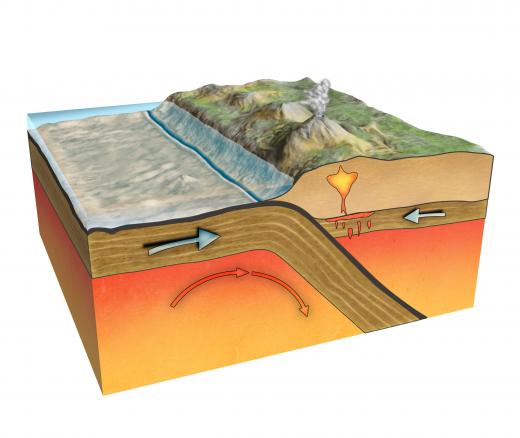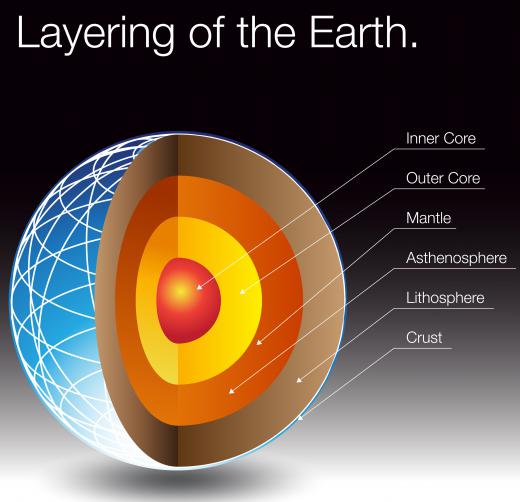What Is Mantle Convection?
Mantle convection is the process by which heat from the Earth’s core is transferred upwards to the surface. It is thought that heating of the mantle by the core creates convection cells in which hot mantle material rises, cooling as it goes, toward the crust until it reaches less dense material, at which point it spreads out then descends. Similar processes can be observed in any fluid above a hot or warm surface — for example, the atmosphere. Mantle convection is assumed to be responsible for plate tectonics and continental drift as well as volcanism.
The Earth consists of three main layers: the core, the mantle and the crust. The core is thought to be composed mainly of iron and nickel, but with a high proportion of radioactive elements; the decay of these elements, along with heat left over from the Earth’s formation, keep the core at a high temperature — thought to be between 5,432 and 10,832 °F (3,000 and 6,000 °C.) Above the core sits the mantle, a layer of hot metal silicate material 1,800 miles (2,900 km) thick, thought to be essentially liquid in its upper reaches, but possibly solid lower down. The topmost layer is the crust, a solid layer of less dense material that floats on the mantle. This consists of oceanic crust — the ocean floor — 4-7 miles (6-11 km) thick and continental crust, 19 miles (30 km) thick.

The crust is broken into continental plates, which, throughout geological history, have slowly moved relative to one another, split and joined together, presumably under the influence of convection processes within the mantle. It is thought that where a rising mantle material approaches the crust, the outward spreading motion causes the sections of crust on either side to move apart. The Atlantic Ocean is thought to have formed in this way and the process continues today, with new oceanic crust being formed by mantle material along the Mid-Atlantic Ridge. There are also a number of “hot spots” where mantle material is forming new land at the surface — for example, Iceland and Hawaii. In some areas — like the west coast of South America — sections of oceanic crust can slide under the continental crust and descend deep into the mantle; these are known as subduction zones.

While the movement of tectonic plates is well established and supported by observable evidence, the processes going on within the Earth’s mantle that drive tectonics cannot be investigated directly. It seems highly likely that convection processes are at work there, but their exact nature remains unclear. Investigations into mantle convection must use indirect methods, such as the behavior of seismic waves and chemical analysis of mantle material that has been extruded at the surface through volcanic activity. Samples of mantle material taken from different locations have been found to differ chemically from one another. This appears to conflict with theoretical models where convection takes place through the entire depth of the mantle as this should lead to thorough mixing of material, resulting in a chemically homogenous magma.
A theory of mantle convection must explain the variable chemical composition of mantle material while agreeing with other observations, and physical constraints, as to the mantle’s structure. In some models, there are distinct layers, with convection taking place in the upper layer, and plumes of material rising from the lower layer. Others involve “blobs” of ancient, deep material floating in the upper mantle. Incomplete mixing of subducted oceanic crust with mantle material may also play a role. Mantle convection is an area of active research and there is, as of 2011, no consensus about the details of the process.
AS FEATURED ON:
AS FEATURED ON:












Discuss this Article
Post your comments